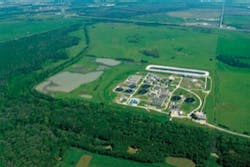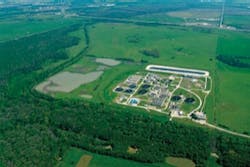By Scott Lawson and Jeff Glover
The City of Rialto, California, has begun operation of a $160 million regional facility that accepts waste from five municipalities in the region, consolidates and dehydrates it, and produces carbon pellets for use as a renewable fuel. The facility generates approximately 60,000 tons per year of "eFuel" with no net carbon dioxide emissions for the surrounding community – the equivalent of 720-megawatt-hours of electricity, or enough to power around 6,500 typical American households.
The Rialto SlurryCarb™ Facility uses heat and pressure to transform biosolids into a CO2 neutral, coal-like renewable fuel.
Constructed by EnerTech Environmental, with HDR and Kleinfelder providing engineering consulting services, the plant is the first commercial-scale SlurryCarb™ facility. Rialto has been able to use this facility to turn wastewater operations from a net energy user to a net energy producer.
The facility is built on one of the first California landfill sites to undergo "clean closure" – the complete removal of all waste and waste residuals, plus significantly impacted soils, then backfilling with a compacted combination of existing materials and imported clean soils. The project demanded a removal depth of 55 feet and the placement of approximately 192,000 cubic yards of backfill material.
Soon after, geotechnical engineers performed confirmatory borings in the compacted fill that allowed them to develop design recommendations for the plant's structures, which have foundation bearing pressures as high as 6,000 pounds per square foot embedded as far as 25 feet below finished grade.
The SlurryCarb Facility uses heat and pressure to transform biosolids into a CO2 neutral, coal-like renewable fuel. Multiple structures were constructed to accomplish the process, including a below-grade biosolids receiving pit, two above-grade biosolids storage silos, and structures for the SlurryCarb area and dryer area. Other facility components included installation of new mechanical equipment, piping, instrumentation and underground utilities, plus the addition of a maintenance vehicle access road and paved parking areas. The biosolids receiving pit, biosolids storage silos, and SlurryCarb and dryer facilities are built of reinforced concrete and/or structural steel.
Community Involvement
Early in the planning stages and throughout construction, the City of Rialto and EnerTech worked to provide the local community with information and address any concerns, particularly related to health, safety and odor.
Throughout the planning and construction process, the city and its contractors focused on public education about the safety of the facility and benefits to the community. These public meetings helped assure residents that the facility is designed to the highest health and safety standards. In response to questions about odor, facility engineers provided demonstrations of the process. From receipt through to final product, biosolids are enclosed within the facility. The processing systems also incorporate air emissions control equipment to prevent odors from escaping the facility.
Rialto officials expect the regional facility to be fully operational by the end of 2010, processing approximately 685 wet tons of biosolids per day.
"The local community has been largely supportive of the facility. Since biosolids are contained within the facility, and eFuel is shipped out for use as a renewable fuel, the health and safety of the surrounding community is protected. The facility has generated local green jobs and provides revenue to the city," said Brian Dooley, vice president of marketing at EnerTech Environmental.
Energy Management
Commissioning of the Rialto facility began in 2009. As this facility is the first of its kind, some design issues were encountered during start-up that led to some modifications of the facility and resulted in improved capacity and availability.
"There were some logistical challenges that had to be worked out initially," Dooley said. "Each of the municipal customers has different requirements such as timing for deliveries. These scheduling issues were easily resolved as the Rialto facility can receive biosolids 24/7."
By late 2009, the facility was accepting waste through its biosolids recycling plant from five Southern California municipalities. Customers include Orange County Sanitation District, the County Sanitation Districts of Los Angeles County and the cities of Rialto, Riverside and San Bernardino.
Rialto officials anticipate full operations by the end of 2010, which translates to approximately 685 wet tons per day.
Powered Up
The Rialto facility is able to process more than 250,000 wet tons of biosolids every year. It uses natural gas to drive the process, which is supplemented with biogas generated by the onsite liquid treatment, reducing the natural gas need. The eFuel is then used by local cement kilns to supplement coal consumption.
The facility is a net energy exporter, meaning there is more energy contained in eFuel than required to produce it. In 2008/2009, an independent firm conducted a comprehensive lifecycle analysis of the GHG emissions at Rialto compared to other biosolids management options. The firm concluded that eFuel will displace about 80,000 tons CO2 equivalent per year.
"Therefore, the net carbon footprint is approximately negative 54,000 tons CO2 equivalent per year when including the GHG emissions from producing the eFuel at the facility," Dooley said.
The city and its project partners will avoid producing greenhouse gas emissions on the equivalent of 16,500 tons of waste that would have been sent to a landfill, according to the EPA. [http://www.epa.gov/RDEE/energy-resources/calculator.html]
The International Economic Development Council (IEDC) recently recognized partners EnerTech, Rialto and the city's redevelopment agency with an award in the Sustainable and Green Development category for organizations serving areas with populations between 50,000 and 200,000. WW
About the Author:
Scott Lawson, PE, GE, is a senior geotechnical engineer with Kleinfelder. He can be reached at [email protected]. Jeff Glover, PE, is a senior project manager and vice president of HDR. He can be reached at [email protected].
More WaterWorld Current Issue Articles
More WaterWorld Archives Issue Articles




